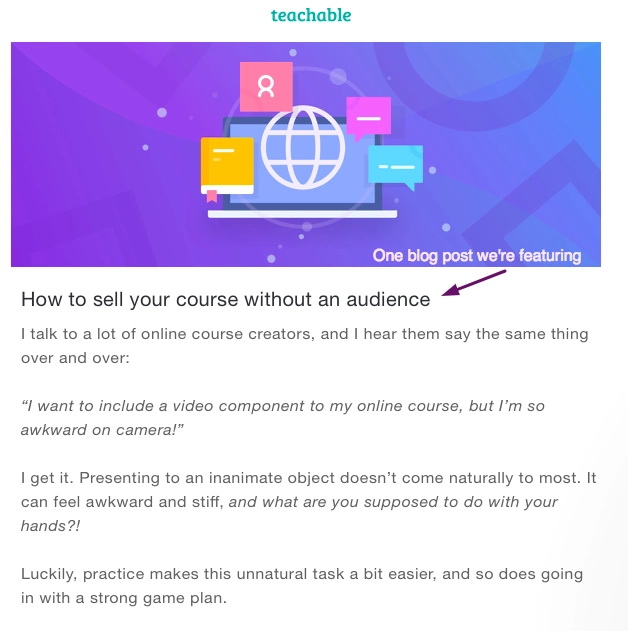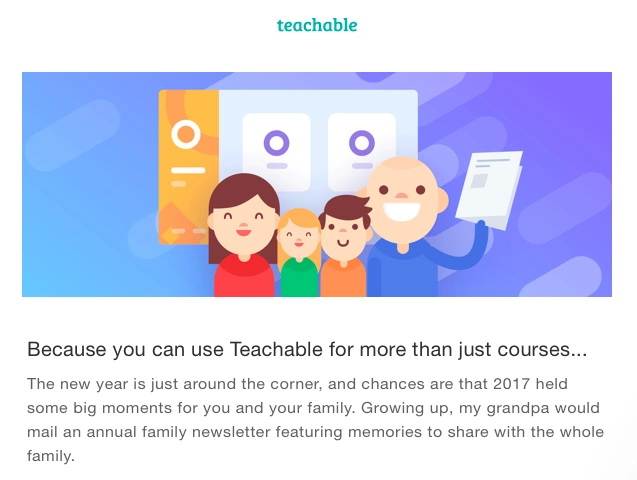If you’ve spent any time at all hanging around the Teachable blog, you’ve probably heard us mention that a newsletter is one of your most powerful tools when making a profit with your online business.
Sure, there’s something to be said for a well-written blog or a killer social media strategy, but at the end of the day, most people find that their newsletter is where they make real money.
Why newsletters are so powerful
Newsletters are by far the most personal connection you have with your audience. Everywhere else, you’re just another voice in the noise.
On Twitter, you’re competing with accounts like Beyonce and Taylor Swift. Your account is one of millions. On the other hand, people tend to be more selective with who they allow in their inbox.
But at the end of the day, you’ve got a better chance of somebody seeing your content if it’s in their inbox and not buried somewhere deep within their social media feed.
Your newsletter is more personal
When you subscribe to somebody’s newsletter, you quickly begin to recognize their name and get to know them through the content they send.
Our favorite newsletters are ones where entrepreneurs let some of their personality shine through. It’s easy to become endeared with somebody who is letting their sense of humor shine and being themselves. And like we said before, it’s easier to even see somebody’s content when it’s in your inbox and not hidden away on social media.
Your newsletter helps you build your readership
It’s somewhat rare for a person to get to somebody’s blog by plugging and chugging it into their search bar. Mostly likely, a reader arrives at a certain blog because either someone sent them a post or they found it through a link in their inbox.
Sure, every website and online entrepreneur has their superfans who will check back in every single day, but the majority of people aren’t going to become your super fan.
So you have to ask them to visit your site, and it’s easy to do by sending them a newsletter linking them to all of your most valuable content.
Why start a newsletter?
So we know that newsletters are powerful, but you might be thinking, “Well, my business model is working for me just fine without a newsletter, and I really don’t have time to add yet another project to my to-do list.”
And we get it. Life as an online entrepreneur is busy. You’re constantly juggling a million different things, and it can feel unrealistic to add yet another to your list.
But you should reconsider.
Even if your current business model is working for you just fine, you can become an absolute powerhouse and start increasing traffic and sales by starting your newsletter.
But even if you aren’t selling anything yet, there are a handful of convincing reasons why you should start your newsletter anyhow.
Newsletters help you build your brand
Remember how we mentioned earlier that people get to know you through your newsletters? Well, you can use your newsletter to make a strong impression.
Make sure people know you as the awesome person who sends valuable content that makes their lives easier every single week.
The way you present yourself online becomes your brand, so if you’re consistent and helpful, that’s how you’ll begin to be known.
Drive traffic to your website
Here at Teachable, we treat our newsletter as an opportunity to say, “Hey, we just wrote this post we thought you might be interested in.” and lo and behold, every Tuesday and Thursday, we get countless visits from our newsletter subscribers.

Prove you have something to offer your audience
As an online entrepreneur, the first thing you need to do to get customers is prove that you can provide value.
An easy way to do that is to show up every single week and offer value to your audience via a newsletter. Whether you’re directing your followers to your latest and greatest resources, or just giving them a dose of unfiltered wisdom, become somebody they associate with value.
Warm your audience up
If you haven’t heard of a “warm” audience, it basically means that they are people who are primed to buy from you.
If someone signs up for your email list in March, but they don’t hear from you until you’re trying to sell them something in July, you’d be selling to a “cold” audience.
On the other hand, if you’re sending them valuable resources four times a month and have proven your worth, they’re a “warm” audience and will convert at a higher rate.
How to format your newsletter
When it comes to formatting your newsletter, there is no right or wrong way to go about it. Different formats work better for different business types.
In fact, we’d recommend trying out a few different options to see which ones you most enjoy creating, and which your audience responds best to.
List of posts
We’ve all seen the classic roundup post again and again. But for good reason.
Highlighting your best posts from the year, or re-sharing old posts that all fit within a certain theme is a great way to get new eyes on old content.
People are constantly signing up for your newsletter, and your newer members haven’t seen the great content your posted a few months ago. Roundups are a great way to keep posts relevant.

Highlight just one piece of content
Here at Teachable, this is our usual strategy. We send out newsletters twice a week, and more often than not we’re sharing just our latest blog post.
This eliminates what we call “option overwhelm.” Some of our favorite newsletters send links to about a dozen different posts that we’re dying to read, but because we don’t have time to read a dozen different posts, we’ll close out of the email saying that we’ll get to it later. However, distractions happen.
If you’re just sharing one piece of content, people can usually justify taking four or five minutes to check it out.

Send a personal note
If your followers are invested in your life (or if you’d like them to be) sending the occasional personal note is a great way to keep them intrigued.
If you’ve built your business around your personal brand, this is an especially effective strategy. Loop your followers in the same way you’d update your long distance bff on what’s going on in your business life.
Here you can toss a bit of formality to the side and be as vulnerable (or not!) as you’d like. Your personal note could let your audience know what you’ve been working on, what your business struggles have been, and any challenges you’ve overcome.
Question
Piggybacking off the last suggestion, it’s also a good idea to let your audience feel involved in your business.
Asking them questions and sending them surveys is a great way to let them know that you value their opinions. At the end of each quarter or year, consider sending a newsletter linking to a survey they can take and offer their ideas for what they’d like to see you do next.
Newsletter strategies
It’s not enough to just write great newsletters and send them every now and then. Instead, go in with a strategy and you’ll find that you’re less stressed and you’ll get a larger return on the time you devote to your newsletter.
How often should you send
The key is consistency: let your audience learn when to expect a newsletter from you, and they’ll be trained to check and read every Monday, for example. With that said, consider how much time you have to devote to creating newsletters.
If you’re hoping to make newsletters the forefront of your marketing strategy or you do have a team in place supporting other aspects of your business, multiple sends each week might be manageable.
At the end of the day, though, it all comes down to the time you have available.
Who to send your newsletter to
Depending on the content you’re sharing, you may decide you need to segment your newsletters. What this means, is that depending on who the newsletter is going to, it might be slightly different. At Teachable, we send a different newsletter to people who are already signed up and to people who are still deciding whether or not to sign up.
This is because each audience is in a different stage of their business and what would help one might not necessarily be what the other wants or needs. By segmenting your list, you’re able to send customized newsletters to increase conversion rates.
For example, if you’re sending newsletters promoting your product, you don’t want to annoy the people who have already bought by sending them half a dozen advertisements. So, you’ll segment that audience and either send them a different newsletter.
When to send your newsletter
You want to be consistent with your newsletter so that your audience can grow to anticipate when you’re going to send. The most dedicated audience members will likely be checking their inboxes at your usual time, so you don’t want to disappoint.
Unfortunately, there is no golden standard for when to send your newsletter.
We did a ton of trial and error with the Teachable audience and settled on sending at 11 AM Eastern, but that is just what works for us.
Here are a few things to consider:
- When is your audience active? Are they stay-at-home moms checking their inboxes at the 3pm pick up line or are they business women not getting home from work until 6pm?
- When do you usually check your inbox? Nobody will have more in common with your audience than you do, so check your habits. Your audience likely has similar ones.
- When is your audience spending the most time online? Maybe they’re checking their emails at 3pm, but not actually spending any real time online until after their kids sleep at 9pm.
Learn their habits and try to send the email when they’re most ready to read.
If you decide to do a bit of trial and error early on, that can help you really pinpoint what times are working for you and your audience. A simple way to check what times work best is by segmenting your list randomly, and sending the same newsletter to each segment, making the only variable the time sent. So, you may try sending to the first group at 7am, and the second at 5pm. From there, check your open rates and see which segment opened more emails.
How to get started
Getting started with your newsletter is fairly simple. At the root, you need 1.) an audience and 2.) content.
That being said, it’s better not to fly by the seat of your pants, and instead lay down the groundwork.
Branding
You want your newsletter to be visually appealing and recognizable.
Most newsletter services make branding your emails easy. All you’ll need to do is create a header image or logo to use in all of your newsletters.

{{homepageguide-component="/blog-shortcodes/blog-popup"}}
A newsletter host
For a smaller business, we’d recommend opting for ConvertKit or MailChimp. They are the two most popular email services for business owners, and both are easy to use and intuitive.
For a detailed comparison of the two, check out this blog post.
A schedule
It’s imperative to let your audience know what to expect, but a schedule can also benefit you, too. For example, we’re big fans of batching our work. If you can, try to knock out several weeks of newsletters in one sitting so you don’t have to worry about them for the rest of the month.
If you know what you’re sending ahead of time, you can get ahead and focus your energy on other aspects of your business without having to break and send a newsletter.
A welcome email
When someone joins your email list, you want to make a great first impression. Consider automating a welcome email that re-introduces who you are and offer them a great piece of content for free.
You can also use this to direct them to your most important and helpful pieces of content.
Join more than 150,000 creators who use Teachable to make a real impact and earn a real income.


